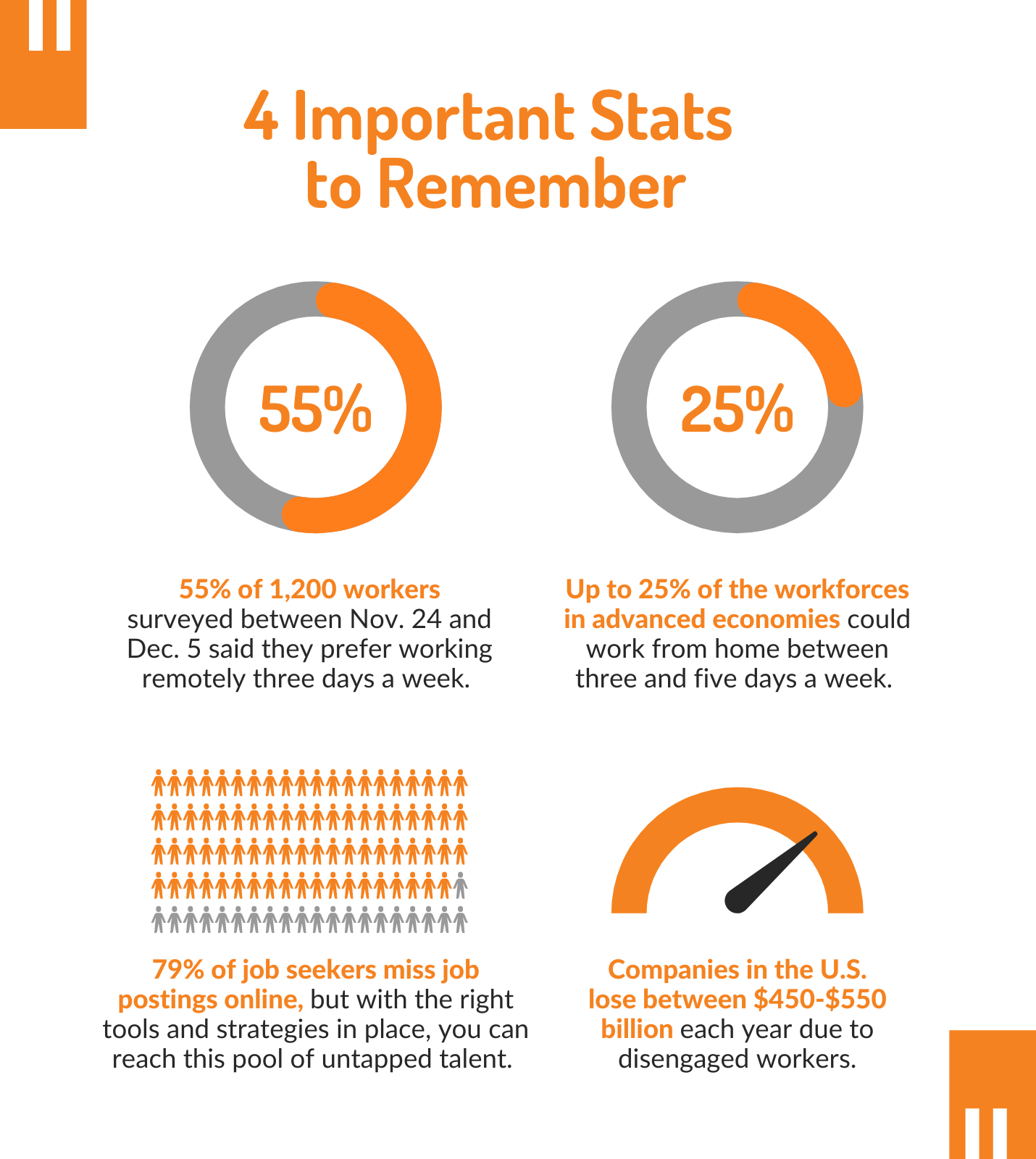Here we are, smack in the middle of a societal transformation. While of course, I refer to all of us, recruiters and TA pros find themselves in the actual eye of the storm. Our expertise is being tried and tested, our old models thrown out the window and it feels as though the world of work...maybe even the future of work relies on our choices over the next few months. Okay, maybe years.
So what are these big changes?
Well, our firm works with companies of all sizes to make hiring easier. And during this period, we’ve seen a couple of things. Firstly, we think there will be an ongoing expectation of Hybrid and WFH models, formerly called “flex”. Then, we feel that reskilling will be a massive trend, the skills we all needed to run our businesses yesterday are not identical to the skills of tomorrow. Beyond that, there are employee health considerations we MUST take into account.
In each of these cases, the game has been turned on its head as we’ve watched the world change under forces we couldn’t control. But now the cat is out of the bag. Work has changed, and it’s time to change with it.
Here are a few ways to prepare you (and your employees) for the Future of Work. In this series, we’ll discuss many of the subjects listed above. First, we discuss employee expectations of WFH and Hybrid work models and how employers and recruiters can prepare.
With remote work becoming more prominent, @RevealGlobal says that the time is now to consider how you can make a Hybrid Work model work for you:Click to TweetThe Expectations of WFH and Hybrid Work Models
Well, you may not have heard it here first but that doesn’t make it less true. Work from home and hybrid work models are now the expectation of virtually every white-collar employee and it holds true for many other industry families as well. Here’s why:
Remember that first text you got? And then had to return? It seemed like SO much work. It was tedious, difficult and more often than not, the response (internal or otherwise) was “Why didn’t you just call me? It’d be so much quicker!”
Nowadays, the opposite sentiment is embraced by virtually all generations (save a few exceptions)...most people would rather communicate via text for quick answers and anything other than conversation.
Well, that’s where we’ve been forced today. Before WFH seemed a pipe dream, for many employers it was a compliance headache and worries abounded with employers that productivity and engagement would tank.
Yet here we are. Forced by lockdowns and stay-at-home orders to alter our work models. What have we learned? Well for one, a lot more jobs are able to work from home than we thought possible. Not only that, but if productivity tanked, it did so momentarily and not necessarily for the reasons we thought (Most research shows loss of productivity came from attempting to educate children simultaneously or the lack of a dedicated or equipped home office.)
The Realities of WFH
Employees also realized a few things they hadn’t anticipated. Many reported Zoom fatigue and reported issues with collaboration. Some missed in-office meetings and camaraderie. For a generation idealizing a full-time remote work option, the reality (flawed though it may be) showed them it might not be the panacea they’d hoped for.
Bottom line? Most workers are hoping for a long-term hybrid strategy. They want to return to work...on their terms. Those range from every day at home, fully remote, to an office space dedicated to them a few days a week. This may make it difficult for employers and companies overall to recruit, hire and retain in the short term.
Many smaller companies are choosing to keep their WFH policies. After all, the collaboration and communication networks are all set up and most of the kinks are worked out. And soaring real estate prices are causing some companies to offer a real estate/home office stipend simply to ensure their people have what they need to work remotely.
With up to 25% of workforces in advanced economies able to work remotely between 3 and 5 days a week, @RevealGlobal says a Hybrid work model is the next frontier:Click to TweetLarger companies, on the other hand, are looking for hybrid or better. They want their people in the office and are bending over backward to ensure they find a way to get them there.
Whichever road your company chooses, here are some things to consider:
Certain roles can work remotely and some just can’t.
If you anticipate that many of your positions will be WFH and some simply cannot be, consider how you’ll adjust KPIs and compensation to bridge the gap. How will you communicate your ultimate policies to your employees? Just as important, how will you communicate it to your potential employees?
Precipitate changes to job descriptions.
As the competition for talent gears up, your job posting and employer branding strategies will have to change markedly to attract and retain top candidates. Today’s job seekers are looking across multiple job boards, social media sites, and company websites to find job postings. Making sure that your advertisement stands out from the crowd will help your recruiting efforts. Think through how you advertise your postings and company culture; some of the things that were selling points in the past may no longer apply. It could be that your “in-office fully stocked beer fridge” is no longer a draw now that there’s ...no office. Or you may find yourself grappling with how to compensate your CIO who moved from San Francisco to Couer d’Alene. Finally, to many SMB’s delight, a whole new world of likely candidates has opened up to them. Enterprise would do well to ensure they are publishing and paying top compensation bands, particularly in this hot market.
Enhance or diminish your company.
What companies have done over the past year, and what they are still doing is just as, if not more important than their “stated” mission and benefits. Many have watched their friends and family summarily dismissed from big-name companies and small, family-run companies alike. More than a robust retirement plan, may be the promise you make to protect your employees during times of uncertainty. By the same token, companies who have worked to keep their employees safe and engaged are reaping the benefits of that strategy during this tight as a drum talent market. Having flexibility around remote work only sweetens the pot when they have a position open.
Best practices breed engaged employees.
Companies in the U.S. lose between $450-$550 billion each year due to disengaged workers.
Many companies have looked to leadership rather than frontline employees to bring about this change. And here at Reveal, we agree this is where this should start. This begins by focusing on catching someone doing something right rather than doing something wrong. When you begin any remote work experiment with the expectation that your employees are going to “cheat you” or “try to get away with something”, chances are, you’ll be proven right. Instead, focus on positive reinforcement:
- Build a best practice library. When an employee creates a new process or has an idea, see if you can create a best practice out of it. Have them formulate and present it at a lunch and learn session. Celebrate innovation!
- Remember to OVER communicate. Communication changes when everyone (or even some folks) is working from home. Remember that tone and intent are VERY rarely conveyed via text alone. Recreate office chatter within your collaboration platform. Make separate channels for important messages, just for fun, and uplifting news or ideas. This way employees know where to go and what to do and how much attention to devote to each channel.
- Have some FUN! Challenge employees to movement competitions, turn on the camera, save time for extraneous chatter. Make sure to have people IN the office turn on their cameras too!
Working from home and hybrid work models are here to stay. How much of that employers choose to embrace is entirely up to them. However, in a tight labor market, it’s a good idea to start weaving flexibility into your employee engagement strategies and your recruitment marketing tactics.
The Future of Work is here. It may not announce itself with trumpets and big, flashy signs. Sometimes it comes through in corners into which we’ve been forced, and habits we never wanted to create. Nonetheless, living in the future requires adaptation from even the most successful of companies to survive. Make sure you’re one of them.



